Ideology and reality in planning and living in real places
Well, I just wrote a great post about these three articles, but Blogger--the new Blogger, out of beta, "ate it." Oh well.
1. Sure there is the more hardcore advocacy from Transportation Alternatives and Streetsblog, but as I've written before, those of us not in New York City think it's the best place in the United States for people and transit vs. the car. The reality is that it's all relative; just because you're good doesn't mean that you can't be better; and you always have to be vigilant because the forces that favor anti-places are strong.
That puts this op-ed from the Sunday New York Times, "The City That Never Walks," by Robert Sullivan, into perspective. From the article:
FOR the past two decades, New York has been an inspiration to other American cities looking to revive themselves. Yes, New York had a lot of crime, but somehow it also still had neighborhoods, and a core that had never been completely abandoned to the car. Lately, though, as far as pedestrian issues go, New York is acting more like the rest of America, and the rest of America is acting more like the once-inspiring New York....
FOR the past two decades, New York has been an inspiration to other American cities looking to revive themselves. Yes, New York had a lot of crime, but somehow it also still had neighborhoods, and a core that had never been completely abandoned to the car. Lately, though, as far as pedestrian issues go, New York is acting more like the rest of America, and the rest of America is acting more like the once-inspiring New York. ...
One reason New York is losing its New York edge may be that the city’s revival is partly based on a strange reversal: the city is the new suburb. Families have returned to the New York that was abandoned years ago for lawns and better public schools. They’ve brought with them a love of cars. A new study by Bruce Schaller, a local transportation consultant, shows that half the drivers in Manhattan are from the city — and that more city residents than suburbanites drive to work every day.
This is the same problem we face in DC. New residents, frequently from the suburbs, unwilling to change or just unthinking when it comes to challenging the automobility paradigm. There are so many SUVs with DC license plates that it boggles the mind.
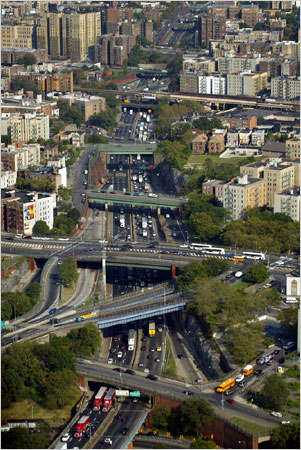
Cross Bronx Expressway. Photo by Andrew Moore.
2. The Times had another troubling story, about the rehabilitation of Robert Moses, the urban renewal and "big project" planner who "inspired" Jane Jacobs and the publication of the urban planning classic Death and Life of Great American Cities. From "Rehabilitating Robert Moses":
FOR three decades his image has been frozen in time. The bulldozing bully who callously displaced thousands of New Yorkers in the name of urban renewal. The public-works kingpin who championed highways as he starved mass transit. And yes, the visionary idealist who gave New York Lincoln Center and Jones Beach, along with parks, roads, playgrounds and public pools.
This is the Robert Moses most of us know today, courtesy of Robert A. Caro’s Pulitzer Prize-winning biography from 1974, “The Power Broker,” which charts Moses’ long reign as city parks commissioner (1934-60) and chairman of the Triborough Bridge and Tunnel Authority (1946-68)....
But according to the Columbia University architectural historian Hilary Ballon and assorted colleagues, Moses deserves better — or at least a fresh look. In three exhibitions opening in the next few days — at the Museum of the City of New York, the Queens Museum of Art and Columbia University — Ms. Ballon argues that too little attention has been focused on what Moses achieved, versus what he destroyed, and on the enormous bureaucratic hurdles he surmounted to get things done.
There is an interesting discussion of why the revisionism, and how Robert Caro, author of a magisterial biography of Moses, is barely included in the exhibitions.
I think it has to do with the continued degradation and diminishment of citizen involvement and civic engagement and the continued focus on big urban renewal-like projects as the dominant municipal economic development paradigm. New York City is particular enthralled with such planning and projects, from the proposed Jets Stadium to the Atlantic Yards-Brooklyn Nets Stadium redevelopment project.
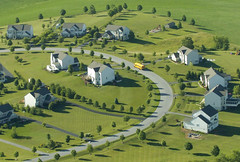
Suburban Baltimore, Baltimore Sun photo by David Hobby.
3. There was a nasty op-ed in the Post Outlook Section by Ted Balaker and Sam Staley of the Reason Foundation. I was a bit disappointed because my previous dealings with Dr. Staley have always been fruitful. I've always appreciated his focus and analysis (this must have something to do with my strain of libertarianism?) . But this piece, "5 Myths About Suburbia and Our Car-Happy Culture," uses straw man type arguments and under-formed analysis to denigrate transit and to promote the car-centric deconcentrated land use and planning paradigm that has dominated the United States since after World War II.
According to Balaker and Staley the "myths" are:
1.Americans are addicted to driving.
2.Public transit can reduce traffic congestion.
3.We can cut air pollution only if we stop driving.
4.We're paving over America.
5.We can't deal with global warming unless we stop driving.
-----------------
1. Maybe Americans aren't addicted to driving, but there is no question that the land use and resource planning paradigm that prevails in the U.S. promotes automobility and deconcentration in ways that are extremely costly to quality of life and local and state government budgets, as well as to national economic, military, and foreign policy.
Many of the pieces in the Richmond Times-Dispatch by Barton Hinkle about Virginia's transportation "crisis" focus on the fact that every new mile of road that is constructed must be maintained in perpetuity, and therefore even more money will be required for maintenance.
2. Public transit can reduce traffic congestion. It does already. Certainly in places that are relatively dense, with job and residential centers connected efficiently by public transit, traffic is reduced. Focusing on national averages is misleading. What matters is how transit and automobility works within specific regions. In the Washington region, the core of the center city, and Arlington County, Virginia have much less in the way of traffic compared to other jurisdictions in our region, because of how the subway system and the complementary bus system serve many people relatively efficiently.
In areas that are much more deconcentrated (a/k/a sprawl), transit is less efficient, taking a long time and many stops to get places.
3.We can cut air pollution only if we stop driving. Hmm, Air pollution is a problem in cities and it usually isn't a function of industry, but from cars. There is no question that urban areas suffer asthma and other respiratory diseases at higher rates. (However, this isn't an issue that I direct much attention to myself. But it matters.) But this isn't necessarily one of the top five arguments against sprawl and automobility anyway.
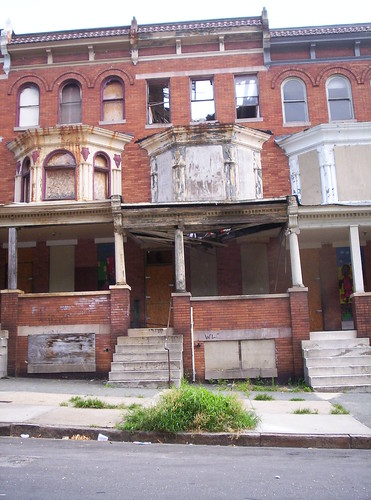
Vacant houses in Reservoir Hill, Baltimore. Goetze argues in Understanding Neighborhood Change, that cities depopulated because overproduction of suburban housing made urban housing less desirable and valuable.
4.We're paving over America. We are. Even if the U.S. "has only developed 5.4% of its total land" there is no question that metropolitan regions are considerably more developed and deconcentrated with the sprawl pattern of land development. Detroit once had 2 million residents in approximately 160 square miles. Today, 1.2 million of those residents have dispersed over close to 3,000 square miles of an ever expanding region.
Similarly, at its peak, DC had 802,000 residents in about 60 square miles (less if you subtract federal land). Fairfax County takes about 400 square miles to house 1 million residents.
National averages are meaningless when looking at this question.
5.We can't deal with global warming unless we stop driving. Maybe. Transportation uses comprise 70% of the oil consumed in the United States. But it's true that industrial use contributes greatly to global warming. Again, this aspect of automobility and the land use paradigm isn't relevant to my day-to-day work on the broad issue. I focus on quality of life and placemaking. Places for people are much different than building places for cars.
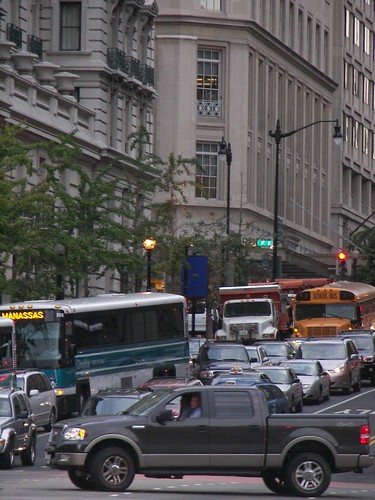
14th Street NW during the evening commute.
As the pro-car, suburban sage of how DC should be operated, Len Sullivan of NARPAC said once in a report about the K Street busway, "Pedestrians are a hindrance."
As long as we attempt to rebuild the cities over for the car, we will lose and destroy those competitive advantages that the center cities possess:
1. Walkable places;
2. Interesting, beautiful places;
3. and a city where people are not dependent on cars for mobility.
In any case, pro-transit, pro-placemaking people and think tanks need to be doing more in the way of writing op-eds!
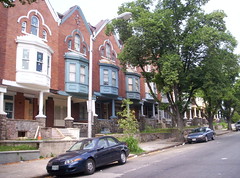
Across the Street in Reservoir Hill. This block is being "homesteaded" in a concerted way through the TechBaltimore program, see this article from the Baltimore City Paper.
Labels: car culture, mobility, transit, urban design/placemaking



0 Comments:
Post a Comment
<< Home